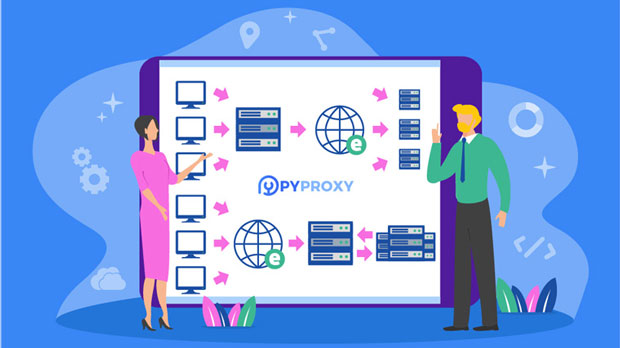What is the difference between the SOCKS5 proxy and other types of proxies such as HTTP proxies?
In the world of online privacy and network management, proxies are commonly used to facilitate anonymous browsing, secure data transmission, and control over internet traffic. Among the various types of proxies, SOCKS5 and HTTP proxies are two of the most frequently discussed. While both are designed to route internet traffic through intermediary servers, their functionality and use cases differ significantly. SOCKS5 is known for its flexibility and capability to handle various types of network traffic, including non-HTTP protocols, while HTTP proxies are typically limited to web traffic. This article will explore the core differences between socks5 proxies and other types, focusing on their distinct characteristics, advantages, and best-use scenarios. 1. What is socks5 proxy?SOCKS5 (Socket Secure version 5) is an advanced type of proxy server that routes internet traffic between a client and a destination server. It functions at a lower level of the OSI model, operating at the transport layer (Layer 4), which means it can handle any type of network traffic, including HTTP, FTP, SMTP, and even non-HTTP protocols like BitTorrent.SOCKS5 proxies offer several advantages over other types of proxies. They support authentication, allowing for additional security by requiring a username and password for access. They also support both UDP and TCP traffic, making them versatile for various applications such as gaming, P2P file sharing, and video streaming.2. What is HTTP Proxy?An HTTP proxy, on the other hand, is specifically designed to handle HTTP traffic. It operates at the application layer (Layer 7) of the OSI model, meaning it is specialized in processing web requests and responses. HTTP proxies are commonly used to access websites, hide the user's IP address, or bypass geo-restrictions.HTTP proxies can only handle HTTP or HTTPS traffic, which limits their functionality compared to SOCKS5 proxies. While they are effective for simple web browsing, they cannot support non-HTTP protocols, such as email, FTP, or other types of data transmission.3. Key Differences Between SOCKS5 and HTTP Proxies3.1. Protocol SupportThe most significant difference between SOCKS5 and HTTP proxies is their protocol support. SOCKS5 can handle all kinds of internet traffic, including HTTP, FTP, SMTP, and even UDP traffic, making it far more versatile than HTTP proxies. This means that SOCKS5 is ideal for a wider range of applications, including P2P networking, VoIP (Voice over Internet Protocol), and gaming.In contrast, HTTP proxies are limited to HTTP and HTTPS traffic. They can only process web requests and cannot handle other types of traffic like FTP or DNS queries. This makes them less suitable for complex or non-web-based activities.3.2. Performance and SpeedWhen it comes to speed and performance, SOCKS5 proxies generally offer better efficiency, especially when dealing with non-HTTP traffic. Since SOCKS5 operates at a lower layer of the OSI model, it bypasses the need for additional application layer processing, which can result in faster data transmission. Additionally, SOCKS5 proxies are often less congested because they are not restricted to web traffic, unlike HTTP proxies that may face more traffic due to their widespread use in web browsing.HTTP proxies, being restricted to handling HTTP and HTTPS traffic, can be more efficient in certain use cases, like web browsing. However, they are generally slower when dealing with large volumes of data or non-HTTP traffic.3.3. Security and AuthenticationAnother area where SOCKS5 proxies have an advantage is in security and authentication. SOCKS5 supports user authentication via a username and password, providing an additional layer of security that can prevent unauthorized access. This is especially important when using proxies for sensitive activities, such as accessing private or corporate networks.HTTP proxies, however, typically do not have built-in support for authentication or advanced encryption. While some HTTP proxies may offer encryption via HTTPS, they are still more limited in terms of secure, anonymous browsing. Additionally, HTTP proxies are more susceptible to DNS and IP leaks, which can compromise anonymity.3.4. Compatibility with ApplicationsSOCKS5 proxies are compatible with a wide variety of applications due to their ability to handle multiple protocols. They can be used for web browsing, file sharing (like BitTorrent), gaming, email transmission, and even streaming media. This versatility makes SOCKS5 an excellent choice for users who need to route different types of traffic through a proxy.In contrast, HTTP proxies are more restrictive, as they can only be used for web-related traffic. They are not suitable for applications that require non-HTTP protocols, such as email clients or FTP servers.4. Best Use Cases for SOCKS5 and HTTP Proxies4.1. Best Use Cases for SOCKS5 ProxySOCKS5 proxies are ideal for users who need flexibility and versatility. Some of the best use cases for SOCKS5 include:- P2P File Sharing: Since SOCKS5 can handle multiple types of traffic, it is widely used in peer-to-peer (P2P) file-sharing networks, such as BitTorrent, where both TCP and UDP traffic are necessary.- Online Gaming: SOCKS5's low-level support for UDP traffic makes it ideal for gaming, where real-time communication is critical.- Video Streaming: Users can bypass geo-restrictions and access region-locked content using SOCKS5 proxies, especially for streaming services that require a higher level of anonymity.- Anonymous Web Browsing: SOCKS5 provides a high level of anonymity, making it useful for privacy-conscious users who want to obscure their IP addresses when browsing the internet.4.2. Best Use Cases for HTTP ProxyHTTP proxies are still valuable in specific situations, particularly for users who only need to route web traffic. Some of the best use cases for HTTP proxies include:- Web Browsing: For users who simply want to hide their IP address while surfing the web, HTTP proxies offer a straightforward solution.- Bypassing Geo-restrictions: HTTP proxies are commonly used to access geo-blocked content on websites, making them a popular choice for streaming media.- Website Testing: Developers often use HTTP proxies to test how their websites perform in different regions or under different IP addresses.5. ConclusionIn conclusion, SOCKS5 proxies and HTTP proxies each have their strengths and weaknesses. SOCKS5 is more versatile, supporting multiple protocols and providing better security and speed for a wide range of applications. It is ideal for activities like P2P file sharing, gaming, and streaming. On the other hand, HTTP proxies are more specialized, best suited for web browsing and simple use cases that involve HTTP and HTTPS traffic. Ultimately, the choice between SOCKS5 and HTTP proxies will depend on the user's specific needs, the type of traffic they wish to route, and the level of security required.
2025-02-19

























































